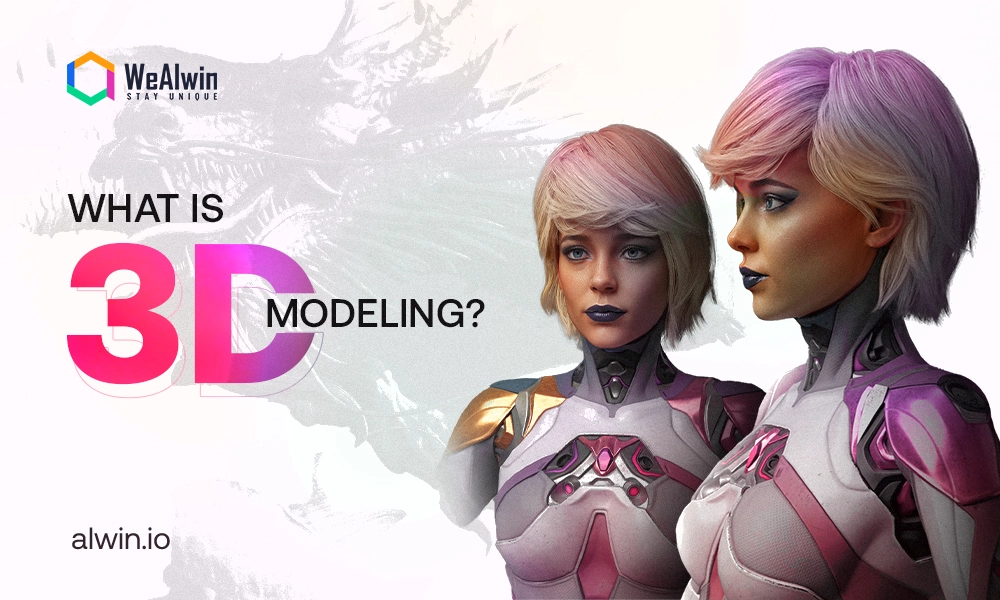3D modeling has emerged as a powerful tool in this digital world that transforms ideas into vivid visual representations. From the captivating landscapes in video games to the stunning effects in blockbuster films, 3D modeling plays a crucial role in various industries, including architecture, product design, and medicine.
But what exactly is 3D modeling?
In this blog, we’ll explore the essence of this art and science, delve into the different techniques and software available, and discover its diverse applications and exciting futures.
What is 3D Modeling?
3D modeling is all about bringing ideas to life in a three-dimensional space using specialized software. Unlike traditional 2D images that only show height and width, 3D models add depth, making them look much more realistic. This extra dimension allows us to capture the true shape and feel of objects and environments. At its core, 3D modeling is about crafting the structure and details of an object using various geometric shapes.
By using 3D modeling software, you can create anything from simple everyday items to intricate characters and expansive landscapes. Once these models are built, they can be manipulated, animated, and rendered, resulting in lifelike images and animations that can be used in a variety of applications, from movies and games to architecture and product design. 3D modeling is an essential tool that bridges creativity and technology, making it a valuable asset in numerous fields.
Basics of 3D Modeling
To understand 3D modeling, it’s essential to grasp a few foundational concepts. At its core, 3D modeling involves the creation of digital representations of objects in three-dimensional space, utilizing key elements like vertices, edges, and faces.
Key Concepts
Vertices: These are the points in 3D space that define the corners of a model. When multiple vertices connect, they form edges.
Edges: An edge is a straight line connecting two vertices. Together, edges create the outline of a model.
Faces: A face is a flat surface enclosed by edges, typically forming a polygon. Most commonly, 3D models use triangular or quadrilateral faces to define their surfaces.
Coordinate Systems
3D models are positioned using a coordinate system that includes three axes: X (width), Y (height), and Z (depth). This allows for precise placement and movement within a three-dimensional environment.
Modeling Techniques
The modeling process can vary significantly based on the technique used. Some approaches focus on building models from basic shapes and refining them into complex forms, while others allow for more organic and freeform creation. Each technique has its strengths and applications that allow artists and designers to choose the best method for their specific project.
3D Modeling Process
Creating a 3D model involves several distinct stages, each contributing to the final result. Here’s an overview of the typical 3D modeling process:
Conceptualization
The initial stage involves brainstorming and gathering ideas for the model. Artists may sketch concepts, create mood boards, or gather reference images to establish a clear version of what they want to create.
Sketching and Planning
Once a concept is framed, artists can create detailed sketches or digital drawings. This planning phase helps outline the proportions, features, and overall design of the model, serving as a guide during the modeling process.
Mesh Creation
In this phase, the actual 3D model is created using software. Artists add details and complexity through basic shapes and gradually refine them. This can involve manipulating vertices, edges, and faces to achieve the desired form.
Texturing
After the model is complete, textures are applied to give it color, surface detail, and realism. This involves mapping images onto the model’s surface to simulate materials like wood, metal, or fabric.
Rendering
Artists position light sources and other visual effects to adjust the intensity and shadows of the model. Lighting is added to the scene to create mood and depth. Once the light is set, the model is rendered and becomes a final image or animation. This step can take time, depending on the complexity and quality setting.
Post-processing
The final stage often involves post-processing, where the rendered images are edited using software to enhance colors, add effects, or make adjustments. This step helps polish the final presentation of the model.
Types of 3D Modeling Techniques
3D modeling encompasses a variety of techniques, each suited to different applications and artistic styles. Here’s a brief overview of some common approaches:
Polygonal Modeling
Polygon modeling is one of the most widely used techniques typically for triangles or quadrilaterals. Artists manipulate the vertices, edges, and faces to define the shape of the object. It’s commonly used in video games and animation due to its flexibility and efficiency.
NURBS Modeling
Mathematical curves are used in NURBS (Non-Uniform Rational B-Splines) modeling to produce smooth, accurate surfaces. This method is frequently preferred in fields where fine surfaces and minute details are crucial, such as industrial and automotive design.
Sculpting Modeling
By simulating conventional clay modeling, sculpting enables artists to mold three-dimensional objects in a more natural and intuitive way. This method is often used in game and film creation since it's great for producing intricate textures and complicated characters.
Procedural Modeling
This technique involves using algorithms and mathematical functions to generate 3D models automatically. It’s ideal for creating complex environments, such as landscapes or architectural elements, where variations and details can be systematically applied.
Retopology
Often used after sculpting, retopology is the process of creating a new, more efficient mesh from a high-resolution model. This is important for optimizing models for animation or real-time applications, ensuring they maintain detail while being manageable in terms of performance.
Popular 3D Modeling Software
Choosing the right software is crucial for effective 3D modeling. Various tools provide different skill levels, project requirements, and industry standards. Here are some of the most popular 3D modeling software options:
1. Autodesk 3ds Max: Powerful software for game development and architectural visualization, known for its user-friendly interface.
2. Autodesk Maya: Comprehensive tool for animators, supporting character rigging and advanced rendering techniques.
3. Blender: Versatile open-source software for modeling, sculpting, and animation, suitable for all skill levels.
4. Cinema 4D: Intuitive software renowned for motion graphics and visual effects in advertising and film.
5. ZBrush: Digital sculpting software focused on creating highly detailed models with a brush-based interface.
6. Fusion 360: Cloud-based CAD/CAM tool integrating product design and engineering for collaborative projects.
7. Tinkercad: Free, beginner-friendly application for simple 3D designs using a drag-and-drop interface and also used for designing electronic circuits and codes.
8. AutoCAD: Standard software for precise 2D and 3D designs in architecture and engineering, with specialized toolsets.
9. SketchUp: User-friendly modeling software popular among architects, featuring a library of pre-made models.
10. Meshmixer: Versatile tool for editing 3D models, particularly useful for 3D printing with sculpting and remeshing features.
Applications of 3D Modeling
3D modeling is a versatile and essential technology with applications across various industries. Here are the key areas where 3D modeling is utilized:
Entertainment and Media: 3D modeling is essential for creating characters, environments, and visual effects in movies, TV shows, and video games, enhancing storytelling and viewer engagement.
Architecture and Real Estate: Architects use 3D modeling to develop detailed virtual representations of buildings and landscapes, allowing clients to experience walkthroughs, which aids in decision-making and marketing.
Product Design and Manufacturing: In product development, 3D modeling enables accurate prototyping and visualization. It allows designers to test functionality and aesthetics before manufacturing, saving time and resources.
Automotive and Aerospace Industries: Used extensively for designing and testing vehicles, 3D modeling helps engineers simulate performance under various conditions and create realistic advertisements for new models.
Medical Visualization: In healthcare, 3D modeling assists with medical imaging, surgical planning, and creating custom implants. It improves the visualization of complex anatomical structures for better diagnosis and treatment.
Education and Training: Educational institutions utilize 3D modeling to enhance learning across various subjects. It allows students to interact with concepts hands-on, such as in-flight simulators for pilot training.
Virtual Reality (VR) and Augmented Reality (AR): 3D modeling supports VR and AR applications, creating immersive environments that enhance user experiences in gaming, training simulations, real estate tours, and interactive marketing.
Environmental Studies: In environmental science, 3D modeling visualizes ecosystems and urban planning projects. It helps researchers analyze spatial data and communicate complex environmental issues effectively.
Conclusion
As we journey into the future of 3D modeling, the opportunities for innovation and creativity are boundless. WeAlwin Technologies, a leading game development company, understands the critical role that 3D modeling plays in creating immersive virtual experiences. Our expertise in crafting detailed and interactive 3D environments allows businesses to engage users in the Metaverse like never before. By integrating advanced modeling techniques with emerging technologies, we help bring your visions to life with enhanced user interaction.



